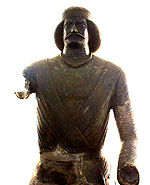
Statue, National Museum of Iran 2401
Encyclopedia

Parthian Empire
The Parthian Empire , also known as the Arsacid Empire , was a major Iranian political and cultural power in ancient Persia...
Art. It is currently in the National Museum of Iran
National Museum of Iran
The National Museum of Iran is a museum in Tehran, Iran. It is the combination of two museums, the old Muze-ye Irân-e Bâstân , and the modernistic white travertine National Arts Museum , inaugurated in 1972...
and was found at Shami (modern Khūzestān Province
Khuzestan Province
Khuzestan Province is one of the 31 provinces of Iran. It is in the southwest of the country, bordering Iraq's Basra Province and the Persian Gulf. Its capital is Ahwaz and covers an area of 63,238 km²...
), where there was an ancient sanctuary.
The bronze statue is 1.94 m high. The man depicted is shown frontally. The figure's head is slightly too small in relation to the rest of its body and the face has a plain, unmodelled surface with an aquiline nose. The man bears a short beard and a heavy moustache, while his hair is long and covers the ears. Around the head he wears a wide ribbon. He wears a tunic with a V-shaped opening at the front and wears trousers. Around the neck he wears a necklace, perhaps a metal ring. The right hand and the entire left arm are missing. In Shami, however, there was found a bronze arm which might belong to this statue.
It is possible that the head and the body of the figure were crafted separately and put together in Shami, as the head is too small and made from a different type of bronze as to the rest of the statue.
The high quality of the art work caused some speculations of its production place. Some scholars believe that it was made by Greek or Roman artists. Other argue that is was produced in Palmyra
Palmyra
Palmyra was an ancient city in Syria. In the age of antiquity, it was an important city of central Syria, located in an oasis 215 km northeast of Damascus and 180 km southwest of the Euphrates at Deir ez-Zor. It had long been a vital caravan city for travellers crossing the Syrian desert...
or by an artist from this city, while others suggest that is was made in Susa
Susa
Susa was an ancient city of the Elamite, Persian and Parthian empires of Iran. It is located in the lower Zagros Mountains about east of the Tigris River, between the Karkheh and Dez Rivers....
(the nearest bigger ancient city).
The statue was found by local peasants but must have originally adorned a sanctuary at Shami, where several Hellenistic bronze statues were found. The statue depicts most likely a local noblemen as worshipper to a local god.
The statue is hard to date. Scholars have proposed various datings ranging from the 2nd century BC to the 2nd century AD.
Literature
- Hans Erik Mathiesen: Sculpture in the Parthian Empire, Aarhus 1992 ISBN 8772883111, p. 165-167

